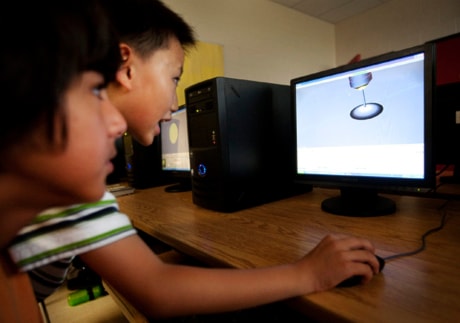MISSISSAUGA, Ont. — They’ve created everything from tables to bowling balls and spaceships, but students attending a computer camp west of Toronto are doing more than putting their own stamp on a digital canvas — they’re taking it to another dimension.
From “Shrek Forever After” to “Toy Story 3” and “Despicable Me,” 3-D animated films have proven to be big business at the box office this year, as moviegoers flock to theatres and don the signature glasses to soak in the specialized visual effects of 3-D rendering.
Students enrolled in the 3-D animation summer course at the Computer Camp 4 Kids located at Mississauga Secondary School are getting a taste of what goes into the process with a hands-on introduction to 3-D animation, while learning how to create their own works.
Course instructors teach students how to use Blender, an open source, cross-platform suite of tools designed for use in 3-D modelling and creation.
“It’s almost like with Blender you get a block of clay, in a sense, and you’re just moulding it and shifting it,” said instructor Kaitlin Fantin.
Instructor Rustom Patel says the weeklong course typically starts off with students learning to manipulate objects and creating simple things like a table, boxes and cylinders before trying to make creations more lifelike and organic, like landscaped trees.
They also show them applications of things they can relate to like video games or movies, he noted.
“If they’re interested in Pokemon or different movies and they let us know, we try to incorporate that into the course,” Fantin said.
Transitioning through a variety of view angles allows for faster modification of objects, and they have an expansive array of tools at their disposal to infuse colour, for instance, or add texture to their scenes.
“It’s a very customizable interface and there’s hundreds of thousands of tools because you can literally make anything you want in 3-D animation,” Patel said. “If you have the knowledge, if you can imagine, you should be able to recreate it.”
Fantin said while artistic skills do give students an upper hand, they still have the tools available to create “something remarkable.”
“The benefit of 3-D animation is not only is it artistic, it’s scientific,” said Shan Abbasi, the camp’s on-site co-ordinator. “So kids who are stronger in math will find some use in that, kids who are stronger in design will find that.”
The course concludes with students learning how to recreate a real-life object in Blender, so they can understand that they translate whatever they visualize into the computer, Patel said.
“It’s incredible to see the growth that they’re actually going through because you teach them something so simple like how to create a box and you get them creating something so real, so vivid and it’s just through four days,” Fantin said.
Patel said when it comes to the distinction between 2-D and 3-D, it isn’t that the latter is inherently more difficult. However, in terms of how individuals might think about and visualize it, it is entirely different, he said.
“It makes sense in a 3-D environment you want something to be further away,” Patel said. “You don’t have to draw it smaller, you can just move the object further away and then the program does it for you.”
Student Thomas Grant had already done work on a table scene complete with cups and plates and a spaceship during the course prior to tackling the creation of a bowling alley.
“I made three bowling balls, one that’s going back into another ball, one that’s in the middle, and an action shot of one that’s getting hit,” said Thomas, showcasing his latest work on a computer monitor in the lab.
The 11-year-old, who previously took an introduction to multimedia course at the camp, said that in addition to the course work, he also liked the time devoted to physical activities, like soccer and basketball.
“They don’t tell you what you have to do,” Thomas said of the course. “They just tell you what you can do, and ’Be creative.”’
Once the course concludes, students are able to save their work on a USB flash drive to continue tinkering away on their projects at home. Since Blender is open-source software and a community-developed program, it is free for anyone to download, Patel said.
But as he always tells students during the opening of the course, when it comes to 3-D animation, if they spend enough time in the program they can one day do even better work than what’s currently out there.
“Technology gets better every year,” Patel said. “You start now, you’ll be able to make things look even more realistic than what you see every day.”
